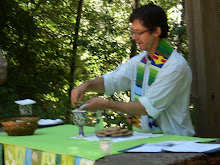 |
| Rocio, Edgar, Karla, and Sebastian Noriega |
About an hour later Sra. Karla Noriega arrived to take us home, accompanied by her husband Byron, and we set out to walk the four or five blocks to their house. On the way, Byron remarked on my San Francisco Giants cap, and asked where we were from. That was when we learned that he knew Petaluma well; his sister lives in Novato. That night at dinner we learned more of the story: how he had been an unauthorized resident alien in Marin County for seven years, starting out as a day-laborer picking up work on the street corner, and eventually finding regular employment painting houses and commercial buildings. He must have obtained a false Social Security Number because I overheard him telling the kids another evening after dinner about the taxes that had been regularly withheld from his paycheck. Apparently Guatemala's current government is making an effort to collect more of the statutory taxes people are supposed to pay but hardly do. From other conversations, anecdotes, and asides I heard during our time in the country I gather it's not going well. But its nice to know that, thanks to the high esteem in which my fellow citizens hold our government, I will be receiving some of Byron's lost income when I retire.
Byron and Karla have three children: Edgar, 15; Rocio, 13; and Sebastian, who if 4. The gap in age between the two older children and their younger brother is due to the seven years That the couple was separated, Karla raising the older children alone in Quetzaltenango while Byron supported the family with the money he earned in California. He came home at the end of that time with enough to buy the house in a working-class section of the city that we shared with the Noriega family, including Byron's mother, and two teenagers from Karla's home town of Solola. They board there during the week, to take advantage of the superior educational opportunities that exist in the city, returning home three hours on the bus every Friday afternoon.
At dawn on Monday mornings Byron backs his pickup out of the living room (yes, you read that right) where it is secure overnight, and goes to his job driving a truck, delivering consumer goods to stores all over western Guatemala. This takes him away from home for most of the week, though he returned for a night on Tuesday or Wednesday both of the weeks that we were there. Although an armed guard rides with him, it is up to Byron to load the truck himself, and because it is too large to enter the narrow streets of most of Guatemala's towns, he has to park it in a central location and then deliver his goods to ten or fifteen stores from there by means of a hand-truck. Effectively, he told me, he works three jobs but receives a single salary, which is far lower than what he earned doing less-skilled work in the U.S.
Yet he is happy to be reunited with his family, if only on the weekends. He has provided them a house of their own, furnished with things he brought back with him in his pick-up on his triumphant return from the States. It enables Karla to earn extra money for the family by hosting foreign students like us from PLQ. Together, they are able to provide a private school education, which is every Central American parent's hope, for their children. This, or something like it, is the American Dream, as it is being lived in cities and villages throughout Mexico, Central America, and the Caribbean. As we in the U. S. crack down on unauthorized immigration, and seek to make an impregnable fortress of our southern border, we are not always aware that we are depriving people like Byron, Karla, and their family of the only realistic path of upward mobility that the world provides. It is their stories that are conspicuously absent from our debates about labor migrants. We do not understand what it costs them to come here, or what it makes possible in their lives.

No comments:
Post a Comment